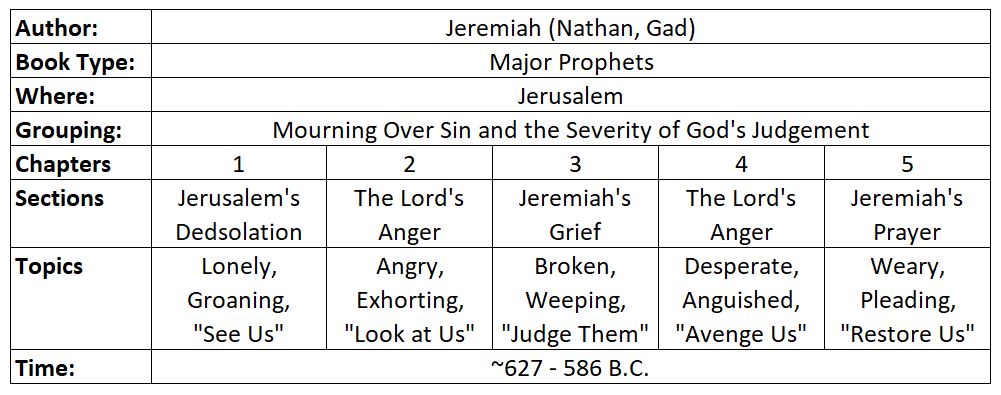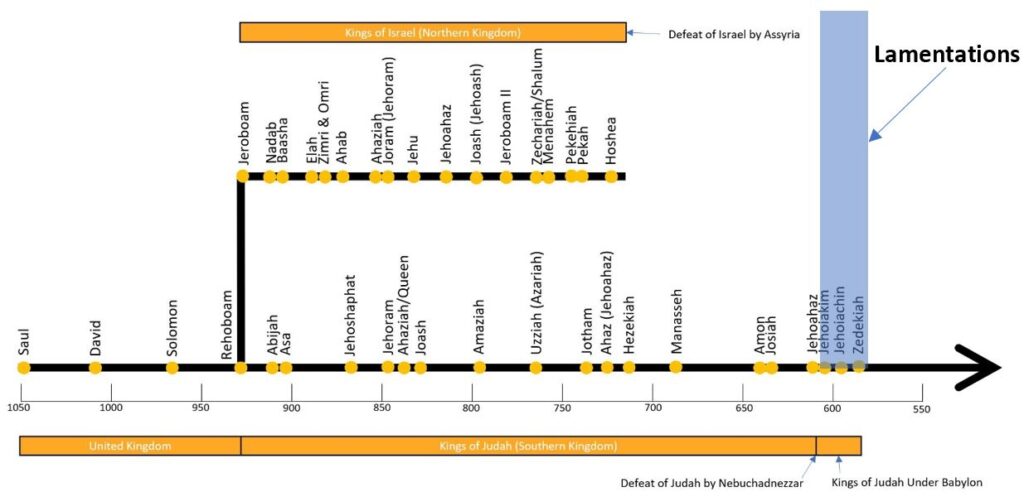Lamentations
Woe to Israel
Summary | About | Why You Should Read it | Author | When Written | Context | Timeline | Location | Outline | Observations | Resources
Summary
The Book of Lamentations is a poetic reflection on the destruction of Jerusalem by the Babylonians in 586 BC, traditionally attributed to the prophet Jeremiah. It expresses the deep sorrow and grief of the people as they mourn the fall of their city, the Temple, and the devastating impact of the Babylonian exile.
Key Themes:
- Grief and Mourning: The book is a series of laments, capturing the overwhelming sorrow and despair following the destruction of Jerusalem. The poems describe the suffering of the people, the ruin of the city, and the loss of hope.
- God’s Judgment: The destruction is understood as the consequence of Judah’s sins, particularly idolatry and breaking the covenant with God. Lamentations acknowledges that the devastation was a result of God’s righteous judgment.
- Suffering of the People: Lamentations vividly describes the intense suffering caused by the siege and destruction, including starvation, death, and humiliation. The book paints a picture of utter desolation.
- Hope and Faith: Despite the grief, there is a strong emphasis on God’s mercy and faithfulness. Lamentations 3:22-23 contains a well-known expression of hope, “The steadfast love of the Lord never ceases; his mercies never come to an end; they are new every morning.”
- Plea for Restoration: The book ends with a plea to God for restoration, acknowledging the suffering and asking for God’s intervention to restore the people and the city.
Structure:
- Chapters 1-2: Laments over the destruction of Jerusalem, the suffering of the people, and God’s judgment.
- Chapter 3: A personal lament, which includes expressions of both deep despair and hope in God’s mercy.
- Chapters 4-5: Further reflections on the suffering caused by the fall of Jerusalem, concluding with a plea for God’s mercy and restoration.
Lamentations provides a voice to express profound grief and suffering while also reaffirming faith in God’s justice and mercy. It serves as a reminder that even in the darkest moments of judgment and suffering, there is still hope for future restoration and healing through God’s compassion.
In summary, Lamentations is a book of profound sorrow over the destruction of Jerusalem, grappling with the consequences of sin, and yet maintaining hope in God’s mercy and the possibility of restoration.
The following table provides a high-level look at the structure and contents of the book of Lamentations.

About
Lamentations is the 25th book of the Bible and the third of the books of the Major Prophets in the Old Testament.

Why You Should Read It
The book of Lamentations is important to us today for several key reasons, as it offers deep spiritual and theological insights:
- Understanding Suffering and Grief
Lamentations is a book that addresses intense grief and suffering, specifically after the fall of Jerusalem in 586 B.C. It provides a framework for lamenting in times of distress. For Christians, it offers an example of how to bring pain, sorrow, and questions before God. It acknowledges suffering honestly, showing that it is okay to express deep emotions and ask difficult questions.
- God’s Justice and Mercy
The book portrays God’s justice in response to the sins of the people, showing the consequences of unfaithfulness. Yet, it also emphasizes God’s mercy and faithfulness, especially in Lamentations 3:22-23, where it says, “The steadfast love of the Lord never ceases; his mercies never come to an end; they are new every morning.” This passage offers hope and reminds Christians that God’s mercy is always available, even in the darkest times.
- A Model for Repentance
The people of Judah in Lamentations are confronted with the results of their rebellion against God. The book demonstrates the importance of acknowledging sin and turning back to God in repentance. For Christians, it serves as a reminder to examine their own lives and to be open to repentance when they stray from God.
- Learning to Trust in God’s Sovereignty
Even amidst disaster and national tragedy, the author of Lamentations holds on to the belief that God is still sovereign. This trust in God’s ultimate control, even when things seem hopeless, is a central theme that encourages Christians to maintain faith through personal or communal hardships.
- Hope Amid Despair
While Lamentations is a book of mourning, it is not devoid of hope. The author expresses hope in God’s restoration, which is central to the Christian belief in redemption through Jesus Christ. Christians can relate to the balance between mourning present circumstances and hoping for future deliverance, both on earth and in the promise of eternal life.
- Resonance with Jesus’ Suffering
Christians see in Lamentations echoes of the suffering of Christ. The themes of rejection, suffering, and redemption align with the narrative of Jesus’ passion, making Lamentations a meaningful text for reflecting on Christ’s sacrifice and God’s plan for salvation.
In summary, reading Lamentations can deepen your understanding of suffering, repentance, and God’s enduring mercy, helping to foster spiritual growth in times of both grief and hope.
Author
It is held by most Christian scholars that Jeremiah the prophet is the author of Lamentations. Despite not being named directly in the writing, this position is held by most based on the historical context, literary style and early Jewish and Christian traditions.
When Written
Lamentations was likely written shortly after the destruction of Jerusalem in 586 B.C. when the fall of the city was still fresh in his mind.
Context
The book of Lamentations was written in the context of Jerusalem’s destruction by the Babylonians in 586 B.C., a defining moment in Jewish history. This catastrophic event not only marked the fall of the Kingdom of Judah but also represented the destruction of the Temple, which was central to Jewish worship and identity. The context of Lamentations is a mixture of deep grief, theological reflection, and an attempt to grapple with the trauma of this disaster.
After years of warning from prophets like Jeremiah, the Babylonians, led by King Nebuchadnezzar, laid siege to Jerusalem. After a prolonged and devastating siege, the Babylonians breached the city’s walls, destroyed the Temple, and burned the city to the ground. Many inhabitants were killed, and the survivors were either taken into exile or left in poverty and ruin. This marked the beginning of the Babylonian exile, where the Jewish people were deported to Babylon and separated from their homeland.
The collapse of Jerusalem was more than just a military defeat. It represented the fall of the Davidic monarchy, the destruction of the Jewish way of life, and the scattering of the people. Many saw this disaster as the direct consequence of Judah’s persistent disobedience to God, particularly idolatry and social injustice.
Timeline
The timeline below shows from the beginning of the monarchy with Saul to the exile period. Jeremiah wrote Lamentations during the beginning of the Exile period.

Location
Jeremiah wrote Lamentations from Jerusalem or shortly after being carried away to Egypt after the third siege of Nebuchadnezzar.

Outline
| I. Jerusalem’s Misery and Desolation (ch. 1) |
| II. The Lord’s Anger against His People (ch. 2) |
| III. Judah’s Complaint — and Basis for Consolation (ch. 3) |
| IV. The Contrast between Zion’s Past and Present (ch. 4) |
| V. Judah’s Appeal to the Lord for Forgiveness and Restoration (ch. 5) |
Observations
- Lamentations describes the funeral of a city—Jerusalem.
- Even in the midst of calamity, Jeremiah cries out to God in Lamentations 3:23 – “Great is your faithfulness.”
- Babylon is God’s instrument of judgment upon Judah.
- Jeremiah writes his lament in an acrostic or alphabetic fashion.
- There are five sections (poems).
- Each section begins with the Hebrew letter A (Aleph) and then proceeds through the Hebrew alphabet with the statements in each of the five poems.
- Jeremiah literally weeps from A to Z.
- The five sections can be divided as follow:
- The Destruction of Jerusalem – Chapter 1
- The Anger of Yahweh – Chapter 2
- The Prayer for Mercy – Chapter 3
- The Siege of Jerusalem – Chapter 4
- The Prayer for Restoration – Chapter 5
- Six centuries later Christ would also weep over Jerusalem. Matthew 23:37-38
- Three themes appear in the Book of Lamentations:
- Mourning over Jerusalem’s holocaust.
- A confession of sin and an acknowledgment of God’s righteous and holy judgment upon Judah.
- A note of hope in God’s future restoration.
- In His sorrow, Jeremiah:
- Sometimes speaks for himself.
- Sometimes speaks for the captives, some 900 miles away in Babylon.
- Sometimes speaks for the personified city.
Old Testament
New Testament
Free Resources
Other Resources
- x
